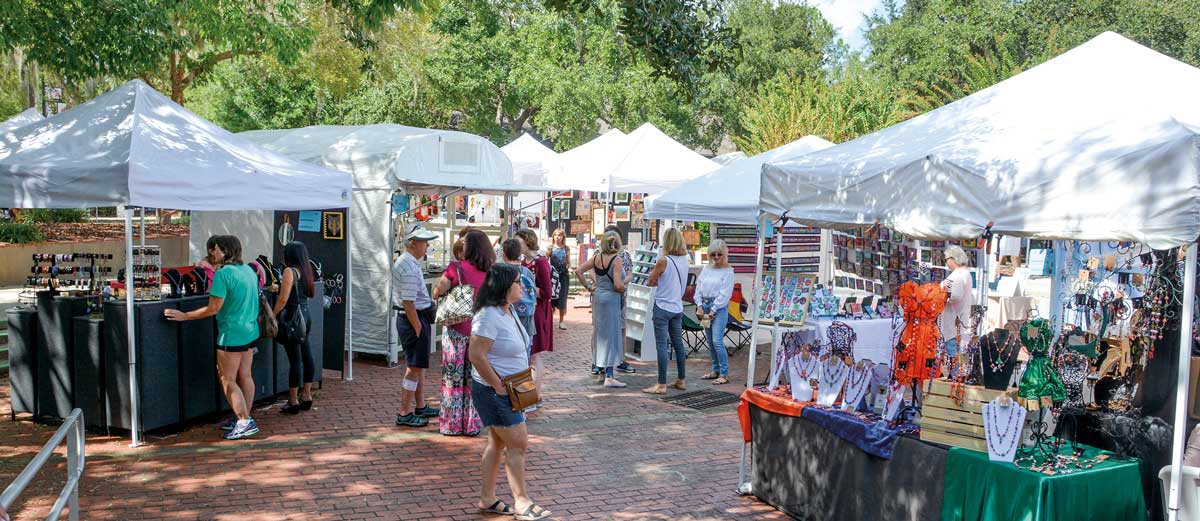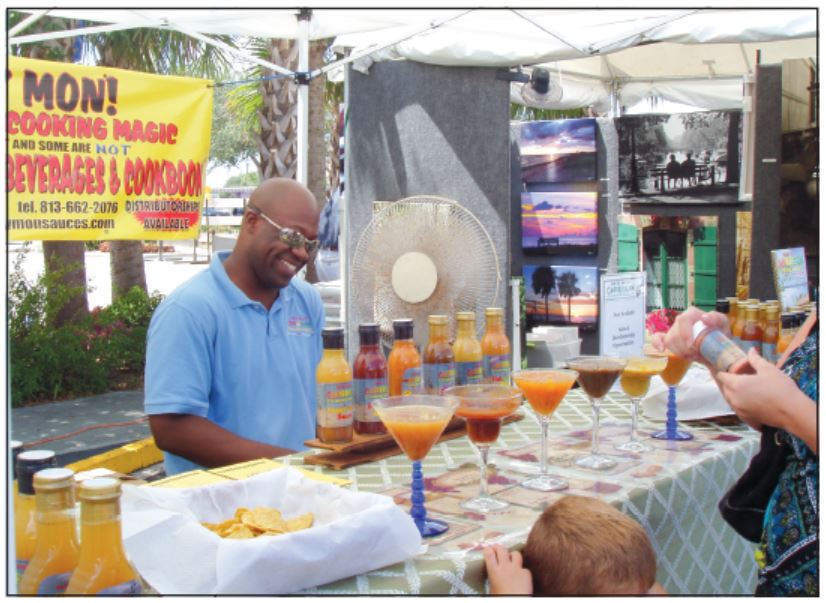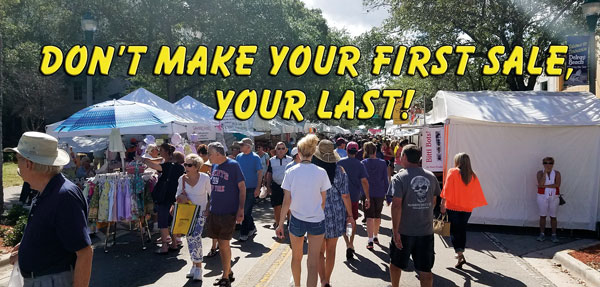I know we’ve all been at shows where we said… “What the heck am I doing here!!!” No matter how well we try, chances are sooner or later we’ll make a mistake and book ourselves into a show where there just plain is a real bad fit! If you’ve participated in a lot of shows and you’ve experienced the thrill of selling like crazy to a crowd that really appreciates your work, then you see the situation immediately and you know the show you’re at is just a bad match. If this is your first show then you may make the mistake of assuming that the work you’re so proud of has no market! Of course that’s probably not true, but if you’ve only done a couple of shows you don’t yet have the perspective to see it that way and chances are you’ll get very discouraged.
I’m bringing this subject up because all too often I run into someone who’s just getting started in the business and they are ready to quit after the first or second show because sales have been extremely slow. I’ll take a look at their work and usually I’ll discover that they are trying to sell crafts at an art show OR more likely I’ll see them with fine art at a country craft show! I don’t mean to say you’ll never make a sale at the wrong type of event and or course these situations are obvious and extreme… but I chose them to demonstrate a point. Matching the RIGHT event to the RIGHT work is one of the biggest challenges we all face when selecting shows.
I’m sure many of you have seen the situation I just described and I’ll bet you’re saying “man, how does he expect to sell anything! It’s so obviously wrong!” But of course three primary factors play an important role here. 1) The exhibitor is very inexperienced and didn’t know how to ask the right questions of the show sponsor. 2) The show sponsor didn’t give a darn and just wanted to sell spaces. And 3) The exhibitor just didn’t know where there was a good match for his work and just needed to make some money this weekend… anything is better than nothing! We’ll handle these problems one at a time.
Situation #1. This one is common to all of us when we start out in the business. Personally we got lucky on the first show we did and so even though a few of the following events were blunders, we knew that good sales were possible and so we endured those that weren’t so good. Especially for beginners, but even for some seasoned professionals… it’s important to remember that the arrangements you are making with the show sponsor is a business agreement and as such you certainly have the right to ask some questions to make sure this is the show for you. Make sure to ask how long the show has been going on. If it’s a first year event then you can bet that participation could be risky and the entry fee ought to reflect that. A high fee on a first year show is only justified under a couple of circumstances… the show sponsor has an impeccable record of successful promotions… the location is proven to draw beyond any shadow of a doubt based on other shows that have taken place there… or the show sponsor shows absolute proof of substantial advertising. When I say “absolute proof” of substantial advertising I don’t mean a promise of advertising, I mean real contracts. And substantial advertising doesn’t mean a two column ad in the local Thrifty Nickel and a couple of Real Estate signs with the words “Craft Show” scrawled across the surface. Ask how many other exhibitors have signed up for the event… you don’t want to be one of five people who show up. What is the advertising plan? What type of work sells best at the event? If you are a fine artist, then you want to be in a show that specifies fine art. If you are a craftsman you want to make sure you’re signing up for a craft show. The two can work together well but usually only when there are distinct sections of the show for each type of work. When customers shop at an event they usually come with a mind-set to view and purchase either fine art or crafts but only under limited circumstances do they come for both types of work at the same show even though we’re talking about the same customer both times! Some events are extremely good at separating and promoting both types of work and of course the combination is a success in those cases! I like to compare it to retail shopping. If you go to Home Depot usually you are in the market for something like lumber or paint or some other home improvement type of merchandise. When you go to the grocery store you are there to buy meat or produce, canned goods or other food. Now that’s not to say you might pick up a piece of candy or a soda at Home Depot… or that if you happened to see a nice set of wrenches at the grocery store they may not make it into your shopping cart. But generally a customer will buy merchandise that he or she sets out to purchase, and they go to the retail location that handles that type of product. The same theory applies to fine art shows vs. craft shows. Presented the right way, “one stop shopping” can work… just make sure the show you’re applying to is one of the successful ones who have figured it out. You don’t want to be in the craft section of a fine art show that was designed simply to provide more revenue for the fine art awards! Are there special exhibit booth requirements or is any kind of display OK? Will there be commercial displays included too? Is this event strictly for artists and craftsmen or will there be other displays and activities as well? Can I drive right up to the place I’ll be exhibiting to unload and tear down (this is especially important if you have heavy items). Can I set up the day before and is there a time limit for tear down. I remember one time we signed up for a show and didn’t realize that the tear down was limited to one hour. If you have a big display of fragile items such as we do, it just doesn’t happen that quickly!
It’s always a good idea to ask for a few names of exhibitors who have participated in the show in previous years so you can talk to them about their feel for the show. If the show sponsor won’t answer your questions, gives “sideways” sort of answers or won’t tell you who’s participated in the past then there’s no question something is being hidden! My feeling is “go the other way fast!” There are plenty of shows to choose from and you don’t need to finance someone else’s folly.
Situation #2. There are some show sponsors who quite frankly don’t give a darn who they rent space to. You might have African American jewelry and be set up next to the Ku Klux Klan booth! Ironically a few of these type of events succeed in spite of themselves. The majority or them fail. If you suspect the show may be like this and the sponsor is all too happy to take your money (which they will be!)… just slow down a little and make sure to do your fact finding. This may be a second string choice if you really need the money, but I wouldn’t pay much of an entry fee, I’d be prepared to leave early if it is too bad and I’d want to reserve the right to relocate my display if I felt my current location was not appropriate.
The best bet is to just avoid these shows and the people who sponsor them. They usually have next to no ethics… and it shows!
Situation #3. Okay, here’s where I get to tout the values of “Where The Shows Are!!!” Now if you’re just reading this because someone else lent their guide to you then now is a good time to turn to the back of the book and fill out the subscription form! Certainly we’d like you to do that… but the reality is that our guide to the events DOES give you a wide choice of shows.
When I first started assembling the information that would eventually become “Where The Shows Are!!!” I did it because we were broke with five kids I needed to apply to most events I participated in last minute. At the time I couldn’t afford to be out the entry fee for more than a few days because it was needed for food, clothing and a place to live. When you don’t have money, the only thing you can have is innovation because it’s free! I needed at least one show every week and when possible we’d participate in two of them. In order to do this last minute you need a lot of information about events because most of the good ones are always full or just don’t take last minute entries. As time went on of course we started selling more and more and the money became available to start booking shows further in advance. Once again the value of having hundreds of shows to pick from right at our fingertips proved to be of great value. After a while the questions isn’t “do I know where there is a show to participate in” it becomes “what is the best show I could choose.”
Track the characteristics of shows where you do well. Because of the unique nature of the work all of us produce, what works well for one person may not work that well for someone else. I know we’ve participated in events where we couldn’t keep the pottery on our display shelves and the guy beside us couldn’t give his work away. The next week we couldn’t give our pottery away and he was sold out the first day! Making the right match with the show we chose explains the difference. When we really stop and analyze the characteristics of shows where we’re successful and then those things that characterize the shows where we fail miserably the consistencies are usually indisputable. Over the years I’ve seen a great many “systems” that attempt to “rate” the shows and provide a sure-fire way you can predict results in advance. Nice work if you can get it… but I have yet to see it really work! BUT, what does work is a careful analysis of those characteristics that produce an outstanding show for you. Think about the physical setting, the income level of the attendee’s, the age of the shoppers, the lifestyle of people in the area, the proximity of major retailers like Wal-Mart or shopping malls, the predominant religious beliefs in the are (Christmas items may not sell well in a Jewish neighborhood). You might also want to consider how well the organization sponsoring the event supports it. Do the members of the organization buy work from the exhibitors? Do they sponsor other activities that detract from sales. Sometimes I’ve seen organizations take the money from exhibitors and then at the event they have booths actually competing for sales. Some show sponsors are under the misunderstanding that you’ve made a charitable contribution to their organization. In fact I’ve even heard them say that from time to time. The nature of the financial supporters also tell you something about the kind of shopper you’re likely to encounter. An event financially supported by someone like State Farm Insurance, Southwest Airlines, Bank of America, the local Tourist Development Association and so forth is more likely to attract a higher end customer than an event sponsored by the local “buy here-pay here” car lot or the “hold-a-check” corner store! As you do shows and find successes and failures, make sure to write down your observations immediately after the show. Don’t wait until a day or two has passed because your observations usually begin to fade with time. Good shows tend to get better as time progresses and the bad shows tend to seem worse! You need the most accurate information possible to produce the best possible data you’ll use for future decisions.
Your best friend in finding a good match for your work is the ability to ask questions along with your skills of observation. Try to be objective in your choice of the shows you apply for. Make a check list and make sure the shows you’re considering meet the criteria you’ve set for a successful event. Don’t be afraid or hesitant to ask questions of the show sponsor because your future and potential profitability in this business may very we rely on it! Chances are that you’ll only rarely make the “perfect match” with the “perfect event.” BUT… the more shows you know about and the more questions you ask, the closer you can get! The closer you get, the more money you’ll make! People will spend thousands of dollars to get the right tools to produce a product. They’ll spend thousands more to buy a truck or trailer to transport that product to a show. That provides only one side of the equation. For less money than the cost of a good dinner on the way home from a show you can have virtually every good show in the area… organized in a way you can use it… and every event is just a phone call away! Remember, no product is worth anything unless you can sell it… and finding the best way to sell it, the best way to display it and the best show to participate in is what we’re all about here at “Where The Shows Are!!!



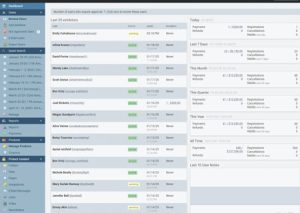

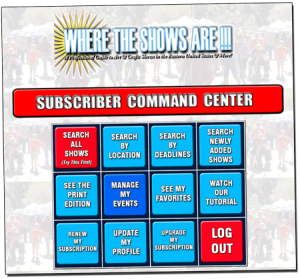




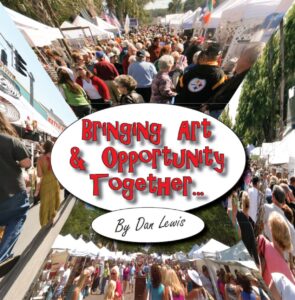







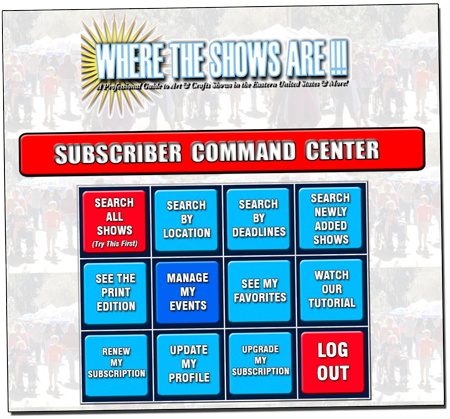


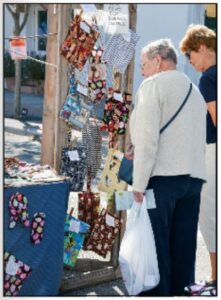 Let the customer know you exist. No one can buy from you if they don’t know about you. I believe this is the marketing phase of selling. It’s a program designed to raise awareness of the product you offer. This can be accomplished by attending and exhibiting at events like we list here in our guide. It can be a result of an internet website. You could hand out flyers or talk up what you’re doing among friends. Home parties have worked well for Tupperware and it’s become a household word. You could advertise in a newspaper, magazine, on TV or maybe even the radio. You may choose an email blast targeted to a specific group most interested in your kind of product. Some people produce seminars or workshops where they demonstrate the product they are selling. There are a million different ways to “get the word out” and let people know about you. However you do it, the marketing of your work is a very important part of what you must do to sell. This is only the first step in the process though and if this is all the further you’re willing to go then you’ll probably be heading home with just about everything you came with!
Let the customer know you exist. No one can buy from you if they don’t know about you. I believe this is the marketing phase of selling. It’s a program designed to raise awareness of the product you offer. This can be accomplished by attending and exhibiting at events like we list here in our guide. It can be a result of an internet website. You could hand out flyers or talk up what you’re doing among friends. Home parties have worked well for Tupperware and it’s become a household word. You could advertise in a newspaper, magazine, on TV or maybe even the radio. You may choose an email blast targeted to a specific group most interested in your kind of product. Some people produce seminars or workshops where they demonstrate the product they are selling. There are a million different ways to “get the word out” and let people know about you. However you do it, the marketing of your work is a very important part of what you must do to sell. This is only the first step in the process though and if this is all the further you’re willing to go then you’ll probably be heading home with just about everything you came with! So how do you tell your story? What makes your work distinct? How do you interact with the customer to let them know? Well part of that starts with you. It’s worth taking a little time to analyze your thoughts and organize them into a cohesive story that’s easy to follow. You can even rehearse it with some willing participants. Initially you could even write a script (that may later become a notecard you place with the piece). For some people this comes naturally… for most, it’s a learned skill. After you get a little more relaxed with the presentation it will come naturally but notes, rehearsal, role playing and the like will get you headed down the right path.
So how do you tell your story? What makes your work distinct? How do you interact with the customer to let them know? Well part of that starts with you. It’s worth taking a little time to analyze your thoughts and organize them into a cohesive story that’s easy to follow. You can even rehearse it with some willing participants. Initially you could even write a script (that may later become a notecard you place with the piece). For some people this comes naturally… for most, it’s a learned skill. After you get a little more relaxed with the presentation it will come naturally but notes, rehearsal, role playing and the like will get you headed down the right path. Ask for the order. OK… this is the close! This is the step where they actually give you’re the money and you actually give them the work. How do we do this… we’ll there are lots of ways… some more direct than others! As simple as this sounds… and as logical as it is… you would be shocked at how many people do absolutely everything correct to this point, but don’t have the nerve to actually ask for the money! They’ve done the presentation. They’ve done fact finding about the customer. They’ve answered questions and overcame objections. The customer is on the verge of pulling out their wallet and the exhibitors says something like… “Well think about it and let me know.” Or worse… he says nothing at all to motivate the customer to move forward with the sale! I’ve watched thousands of exhibitors sell… I’ve seen this kind of thing happen over and over again. They go home with dismal sales while some guy a few booths down the row can’t find time to count his money! What’s the difference? ASK FOR THE ORDER!
Ask for the order. OK… this is the close! This is the step where they actually give you’re the money and you actually give them the work. How do we do this… we’ll there are lots of ways… some more direct than others! As simple as this sounds… and as logical as it is… you would be shocked at how many people do absolutely everything correct to this point, but don’t have the nerve to actually ask for the money! They’ve done the presentation. They’ve done fact finding about the customer. They’ve answered questions and overcame objections. The customer is on the verge of pulling out their wallet and the exhibitors says something like… “Well think about it and let me know.” Or worse… he says nothing at all to motivate the customer to move forward with the sale! I’ve watched thousands of exhibitors sell… I’ve seen this kind of thing happen over and over again. They go home with dismal sales while some guy a few booths down the row can’t find time to count his money! What’s the difference? ASK FOR THE ORDER! Sometimes you’ll get the price objection. Mostly this isn’t actually true… most likely what they are looking for is an excuse to buy. You may not want to ever concede on price. But chances are if you don’t sell to this person now you never will. NEVER give a huge discount in the initial negotiation! In fact, rather than a discount, sometimes it’s better to give added value. That way it supports your price structure and if you have another customer considering a similar purchase you don’t run the risk of having to discount that sale too! If you sell pottery and they buy a set of coffee mugs… you could for example throw in a sugar bowl. If you sell prints, you could discount the frame by 25%. If you do have to change the price, don’t ever offer more than just a very small discount initially. This sets the whole pace of the negotiation and more or less defines the value of your work. If it were a $100.00 piece I might discount say $5.00 and make it $95.00. You’d be surprised at just how many people will go ahead and buy. In a substantial number of cases the discount isn’t really the issue. It’s the principal attached to the success of negotiation. Or it’s that “little excuse” that gives them the reason to buy now. It’s all really more a “mind game” than anything else… after all. If $5.00 really makes that much difference in the purchase… or $25.00 for that matter… what the heck are they even doing here! They need to be spending their money on food and housing… not on art! Well that’s about it. Everyone has a built in fear of sales to start with. When you stop to think about it what is that fear anyway? After all… who is afraid to take money and see happy customers walk away with their work? No one I know! The fear of sales is really the fear of rejection and especially when you’ve conceived the work yourself, created it with your hands, put your personal expression into it… and sometimes you’ve laid your soul bare to present it… you’re bound to take it personally if someone doesn’t like it! Well the reality is that the art or craft we create is unique. And there is absolutely nothing “objective” about a personal creation. To some we’re a creative genius… to others we are out of our minds and all out taste is in our mouth… it’s just the nature of the beast. If you’re going to sell art or craft, then you must develop a thick skin and divorce yourself from the very emotion that allowed you to create the work in the first place. Get elated when people love what you make… and learn to accept that some people just have really bad taste!!! In any case… keep in mind the basics. Let the customer know you exist… tell them what you do… show them how they can benefit by owning your work… and ask for the order. These simple steps will serve you better than all the fancy sales techniques and closes you’ll ever study!
Sometimes you’ll get the price objection. Mostly this isn’t actually true… most likely what they are looking for is an excuse to buy. You may not want to ever concede on price. But chances are if you don’t sell to this person now you never will. NEVER give a huge discount in the initial negotiation! In fact, rather than a discount, sometimes it’s better to give added value. That way it supports your price structure and if you have another customer considering a similar purchase you don’t run the risk of having to discount that sale too! If you sell pottery and they buy a set of coffee mugs… you could for example throw in a sugar bowl. If you sell prints, you could discount the frame by 25%. If you do have to change the price, don’t ever offer more than just a very small discount initially. This sets the whole pace of the negotiation and more or less defines the value of your work. If it were a $100.00 piece I might discount say $5.00 and make it $95.00. You’d be surprised at just how many people will go ahead and buy. In a substantial number of cases the discount isn’t really the issue. It’s the principal attached to the success of negotiation. Or it’s that “little excuse” that gives them the reason to buy now. It’s all really more a “mind game” than anything else… after all. If $5.00 really makes that much difference in the purchase… or $25.00 for that matter… what the heck are they even doing here! They need to be spending their money on food and housing… not on art! Well that’s about it. Everyone has a built in fear of sales to start with. When you stop to think about it what is that fear anyway? After all… who is afraid to take money and see happy customers walk away with their work? No one I know! The fear of sales is really the fear of rejection and especially when you’ve conceived the work yourself, created it with your hands, put your personal expression into it… and sometimes you’ve laid your soul bare to present it… you’re bound to take it personally if someone doesn’t like it! Well the reality is that the art or craft we create is unique. And there is absolutely nothing “objective” about a personal creation. To some we’re a creative genius… to others we are out of our minds and all out taste is in our mouth… it’s just the nature of the beast. If you’re going to sell art or craft, then you must develop a thick skin and divorce yourself from the very emotion that allowed you to create the work in the first place. Get elated when people love what you make… and learn to accept that some people just have really bad taste!!! In any case… keep in mind the basics. Let the customer know you exist… tell them what you do… show them how they can benefit by owning your work… and ask for the order. These simple steps will serve you better than all the fancy sales techniques and closes you’ll ever study!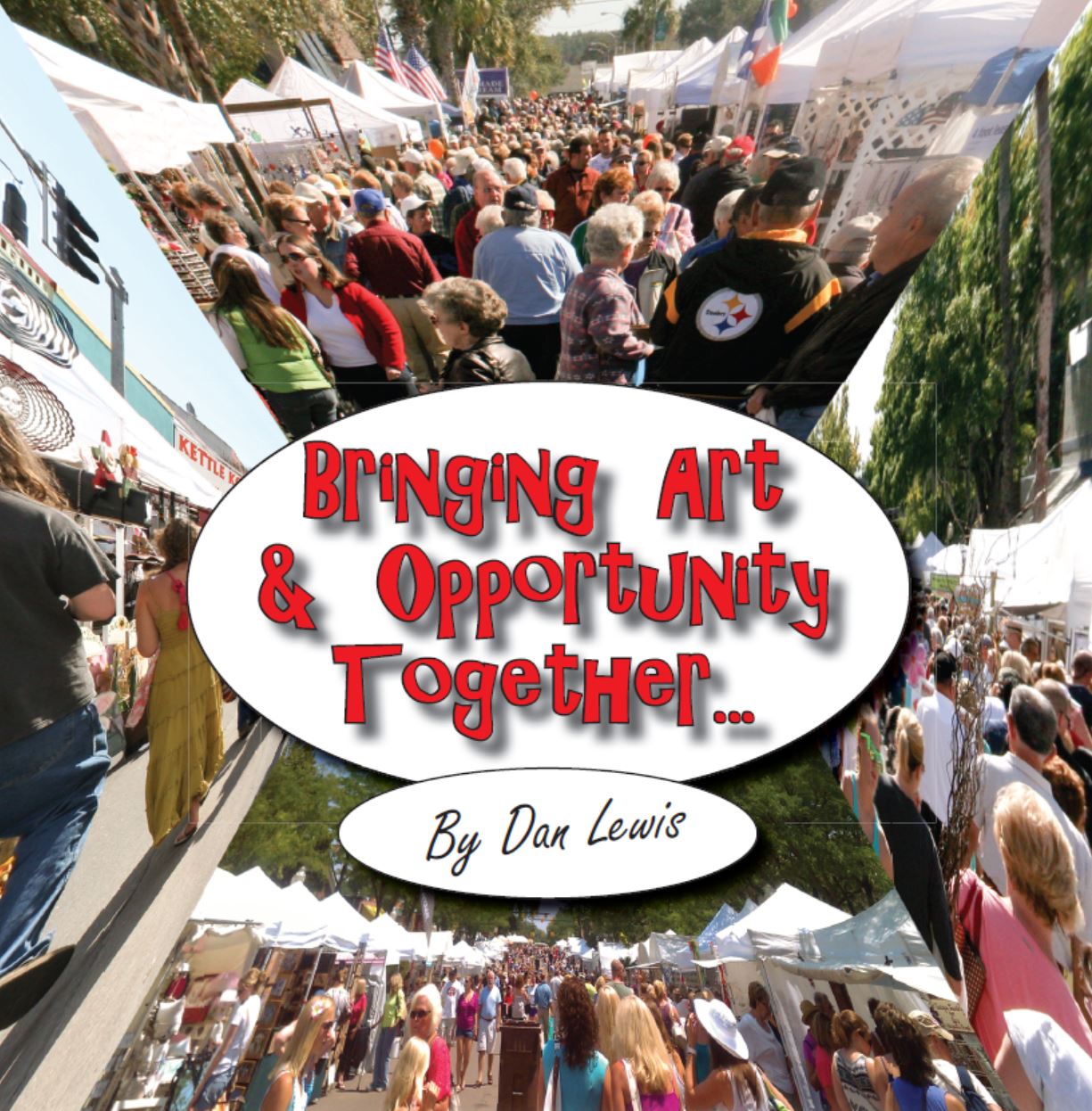
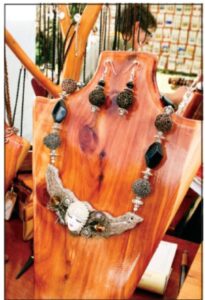 2. “Have It Your Way” in the construction and design world. The big box retailers would have you believe that the only way to decorate a home, build furniture or add accessories is to come to their store and purchase something made in a factory somewhere in a developing country. Well long before there were places like Home Depot, Ikea, Lowes, Rooms To Go and Wal-Mart, there were artists and craftsmen who interacted with the designers and builders to create just what the customer had in mind. If you can get beyond that mindset… the opportunity still exists today. How many of you could create the perfect stained glass piece for an entry way… or the perfect door for a shower enclosure? Why stick with some shelf from Ikea that will fall apart in a year or two when you could have something make with quality materials that would last decades? I’ll bet a lot of people remodeling a home or an office would gladly invite the opportunity to have just exactly what they want rather than settle for some design or idea that is mass produced. The trick here is to let the right people know what your capabilities are. If the architect is designing a building with the idea that Lowes will be supplying all the materials… then he’ll base his designs on that concept. If he knows you can provide something else… and turn his idea’s into reality then it expands the creative possibilities for both of you! Make sure you contact all the builders, architects, designers, remodeling companies, furniture stores and more in your area.
2. “Have It Your Way” in the construction and design world. The big box retailers would have you believe that the only way to decorate a home, build furniture or add accessories is to come to their store and purchase something made in a factory somewhere in a developing country. Well long before there were places like Home Depot, Ikea, Lowes, Rooms To Go and Wal-Mart, there were artists and craftsmen who interacted with the designers and builders to create just what the customer had in mind. If you can get beyond that mindset… the opportunity still exists today. How many of you could create the perfect stained glass piece for an entry way… or the perfect door for a shower enclosure? Why stick with some shelf from Ikea that will fall apart in a year or two when you could have something make with quality materials that would last decades? I’ll bet a lot of people remodeling a home or an office would gladly invite the opportunity to have just exactly what they want rather than settle for some design or idea that is mass produced. The trick here is to let the right people know what your capabilities are. If the architect is designing a building with the idea that Lowes will be supplying all the materials… then he’ll base his designs on that concept. If he knows you can provide something else… and turn his idea’s into reality then it expands the creative possibilities for both of you! Make sure you contact all the builders, architects, designers, remodeling companies, furniture stores and more in your area. 4. Go Directly To The Buyers. It’s great when the buyers are looking for you and lined up to buy your work. Of course that is everyone’s dream, but it doesn’t happen all that often. So when the bank account is getting low and the customers aren’t lining up in front of you… it may be time to go to them! Chances are there really are people who want to buy, but they just don’t know what you have for sale. In fact, I’d be willing to bet that only a very few people you know are fully aware of what you do. That’s not really so unusual… of the people you associate with, how many of they do you know exactly what they do?
4. Go Directly To The Buyers. It’s great when the buyers are looking for you and lined up to buy your work. Of course that is everyone’s dream, but it doesn’t happen all that often. So when the bank account is getting low and the customers aren’t lining up in front of you… it may be time to go to them! Chances are there really are people who want to buy, but they just don’t know what you have for sale. In fact, I’d be willing to bet that only a very few people you know are fully aware of what you do. That’s not really so unusual… of the people you associate with, how many of they do you know exactly what they do?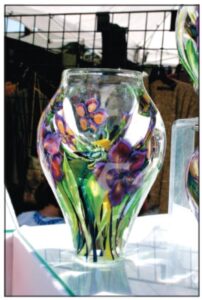 8. Find an Agent. No matter how good you are… no matter how many credentials you carry… and no matter how much success you’ve had… when you start talking about your accomplishments it’s hard not to sound like you’re bragging. In fact, the more you’ve done… the more you run this risk and that apparent attitude can cost you as much work as it gains for you. But when a third party starts talking about you and your work. When he tells a prospect about all the wonderful things you’ve done and adds a whole lot of superlatives… it’s not bragging… it becomes the stuff of which future work and higher prices are made of!
8. Find an Agent. No matter how good you are… no matter how many credentials you carry… and no matter how much success you’ve had… when you start talking about your accomplishments it’s hard not to sound like you’re bragging. In fact, the more you’ve done… the more you run this risk and that apparent attitude can cost you as much work as it gains for you. But when a third party starts talking about you and your work. When he tells a prospect about all the wonderful things you’ve done and adds a whole lot of superlatives… it’s not bragging… it becomes the stuff of which future work and higher prices are made of!